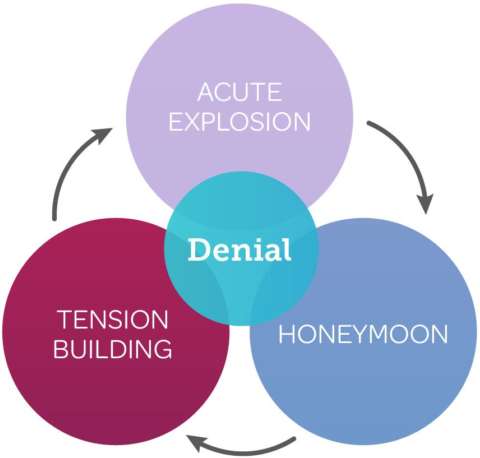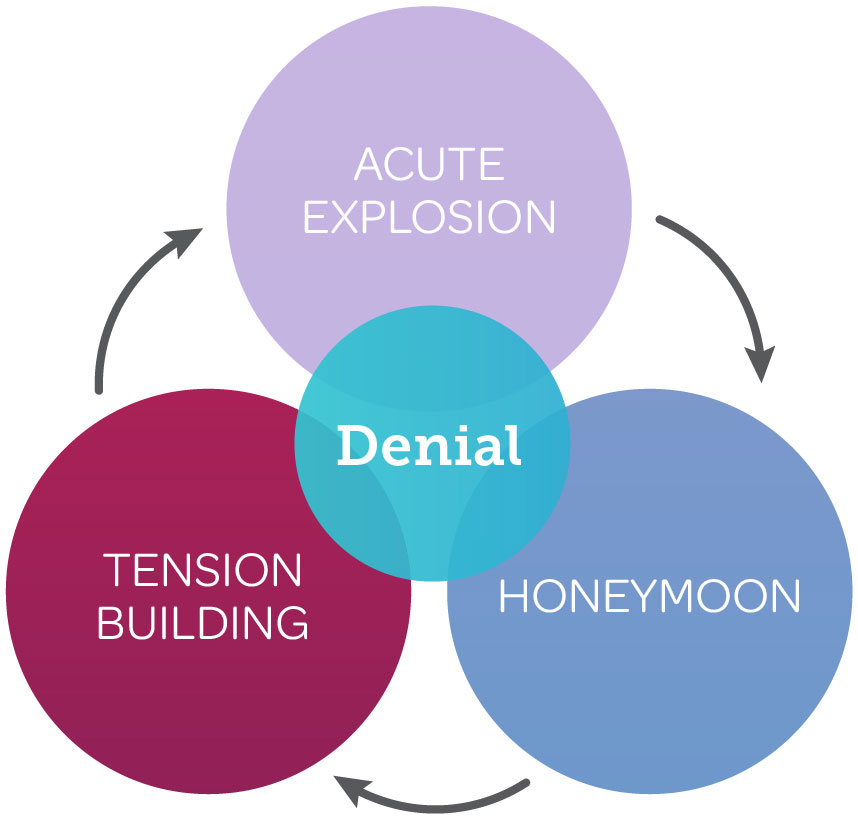
Stay Informed
Creating a community free of domestic violence requires continual information sharing and dialogue. Stay connected with us through the information resources on this page and – please – share what you learn.
Stay Informed
Join Our Email Newsletter
The Cycle of Violence

The cycle of violence is a repeating pattern often seen in abusive relationships. It involves three different stages that continuously repeat until the victim is able to leave the relationship. What often makes the situation even worse is that as the cycle continues the violence often escalates and worsens.
Tension Building Stage
Offender:
The offender becomes increasingly agitated and aggressive.
Some behaviors include:
- Crazy-Making
- Criticizing
- Displaying moody behavior
- Drinking/drugs
- Nitpicking
- Putting-down
- Threatening
- Withdrawing affection
- Yelling
Victim:
The victim senses the offender’s agitation and has the feeling of walking on eggshells. The victim will do anything to avoid the impending explosion.
Some behaviors include:
- Agreeable/rarely disagrees
- Attempting to calm/soothe
- Intense focus on keeping children quiet
- Excessive nurturing
- Staying away from family and friends
- Trying to please abuser
- Trying to reason with abuser
Acute Explosion
Offender:
The offender initiates aggressive, verbal or physical abuse, in attempt to control and oppress the victim.
Some behaviors include:
- Destroying property
- Hitting
- Humiliating
- Imprisoning
- Raping
- Strangulating
- Using weapons
- Verbally abusing
Victim:
The victim may feel the need to protect themselves, escape, or call for help.
Some behaviors include:
- Leaving
- Police called by victim or witness
- Protecting self
- Trying to calm offender
- Trying to reason
Honeymoon Stage
Offender:
The offender feels guilty for inflicting abusive behavior, primarily out of a concern of being found guilty of abuse, shamed by others, or left by the victim, rather than feelings of sympathy for the victim.
Some behaviors include:
- Begging for forgiveness
- Crying
- Declaring love
- Enlisting family support
- Initiating romance gestures
- Promising to get help
- Self-mutilation
- Wanting to get counseling
Victim:
The victim feels relieved, cared about, and questions their responsibility for the abuse. They are happy to be in a place of peace and the victim believes there is hope for the future of the relationship.
Some behaviors include:
- Agreeing to stay
- Attempting to stop legal proceeding
- Feeling happy and hopeful of change
- Returning to taking back the offender
- Setting up counseling
The cycle of violence could occur hundreds of times in a relationship, and the severity and recurrence all depends on those involved. The stages themselves can even vary in length depending on the relationship. The cycle describes a pattern and a possible explanation for how and why victims stay in an abusive relationship. Often times in the honeymoon stage, the offender shows a side of themselves that the victim may truly love, pushing them further into the relationship and the continuous cycle. However, no matter how long the honeymoon phase lasts, or how severe the explosion becomes, the cycle needs to come to an end, and Marjaree Mason Center is here to help.
If you or someone you love is experiencing this dangerous cycle of violence call Marjaree Mason Center’s 24 hour confidential hotline at 559.233.HELP (4357) & help@mmcenter.org.
